Air Force May Soon Offer Service-Wide Mobile Alert System
Military.com, Feb 07, 2017, by Oriana Pawlyk
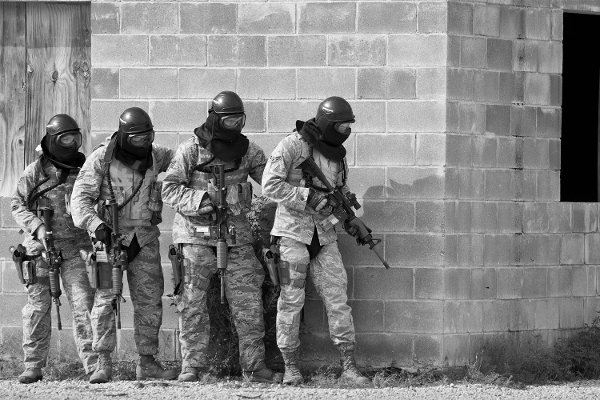
A team of 96th Security Forces Squadron Airmen prepare to enter a building during a shoot, move and communicate drill in June at Eglin Air Force Base, Fla. (U.S. Air Force photo/Samuel King Jr.)
The U.S. Air Force may soon roll out a service-wide mobile alert system to notify airmen and employees of active shooters or other emergencies on base, a general said.
The service is pushing to set up the technology this year, possibly even within the next few months, according to Lt. Gen. John Cooper, Air Force deputy chief of staff for logistics, engineering and force protection at the Pentagon.
"We challenged ourselves: can we get an amber alert-type [system] on cell phones?" Cooper said during a recent Air Force Association breakfast near Washington D.C. "Before the end of this year -- I think in the next three months, but I'll say before the end of the year -- the whole Air Force will be set up regionally."
The Air Force, as well as the other branches,
have stepped up the use of social media websites such as Facebook and Twitter to get the word out to base personnel and families on emergencies and quickly developing situations.
But the direct messaging systems will be created to alert airmen -- and any local command posts in the same region, Cooper said. For example, in the National Capital Region, or NCR -- the area in and around Washington, D.C. -- military bases have already established a unified system, he said.
"In the NCR, the Navy had a program, the Army had a program, Air Force had a program and the Marines had a program. [But] if something happened on Bolling Air Force Base, [in Maryland] I could be driving to the B-X from my house and all the sailors would be jumping in a ditch, and I'd be jumping right into the fire," Cooper said. "We got that all fixed, so any command post in the National Capital Region…pushes a button and every military gets notified immediately."
The general also said the system shouldn't be monopolized by a major command, citing Hill Air Force Base, Utah, a base with two different active-duty commands -- Air Force Material Command and Air Combat Command -- as well as an Air Force Reserve Command unit.
"They're [all] the same Air Force," he said. "One person should push a button and everyone should get notified."
The Air Force immediately began increasing its protection services at various bases, implementing lower-end, but critical enhancements such as preventative fences and bullet resistant film for glass in the wake of the deadly 2015 shootings in Chattanooga, Tennessee, which killed four Marines and a sailor at a recruiting station and reserve center, Cooper told Air Force Times in July.
In 2016, the service implemented three more programs -- Unit Marshal, Law Enforcement Officer Safety Act, and Security Forces Staff Arming -- that allowed more airmen to carry firearms in the workplace.
"We basically set up a concept so an airman can arm themselves with their personal weapon until they get to the office, the worksite -- and from there at the worksite, at the base, the government will make it more secure," Cooper said Friday.
The security forces program enables more security forces members -- who have the appropriate Air Force specialty code and who work in staff billets at the squadron, group, wing or major command -- to carry a government-issued weapon while on duty with the approval of the installation commander, according to a release.
Unit Marshal, the newest program, gives commanders permission, with the installation commander's approval, to work with security forces to train more airmen and allow them to open carry an M9 pistol in their duty location, the release said. UMP is meant to act as "a blocking force," Cooper said. "Somebody comes into an office that's going to do something stupid a blue could shoot back and basically block until the [remaining law enforcements] get there," Cooper said.
Lastly, with the Law Enforcement Officer Safety Act or LEOSA, "Congress gave us legislation ... which allowed credentialed defenders to carry concealed weapons on base, and the Air Force used it; we actually paid for our airmen to get the credential but we didn't enforce it, [but] we kicked that in after Chattanooga," Cooper said.
The legislation applies to present security forces members as well as separated or retired members as long as they meet appropriate criteria cleared by the service. The 2004 federal act was extended to apply to military personnel in 2013.
The Air Force's programs already go hand-in-hand with policies stated in a Nov. 18 Defense Department directive approved by Deputy Secretary of Defense Robert Work that allow Defense Department personnel to carry firearms and employ deadly force while performing official duties.
"When you say high-consequence, I think our airmen," Cooper said. "Chattanooga. We just say Chattanooga and everybody on my staff understands that."
-- Oriana Pawlyk can be reached at This email address is being protected from spambots. You need JavaScript enabled to view it.. Follow her on Twitter at @Oriana0214.
701 MUNSS/Custody Unit ... is standing out!!
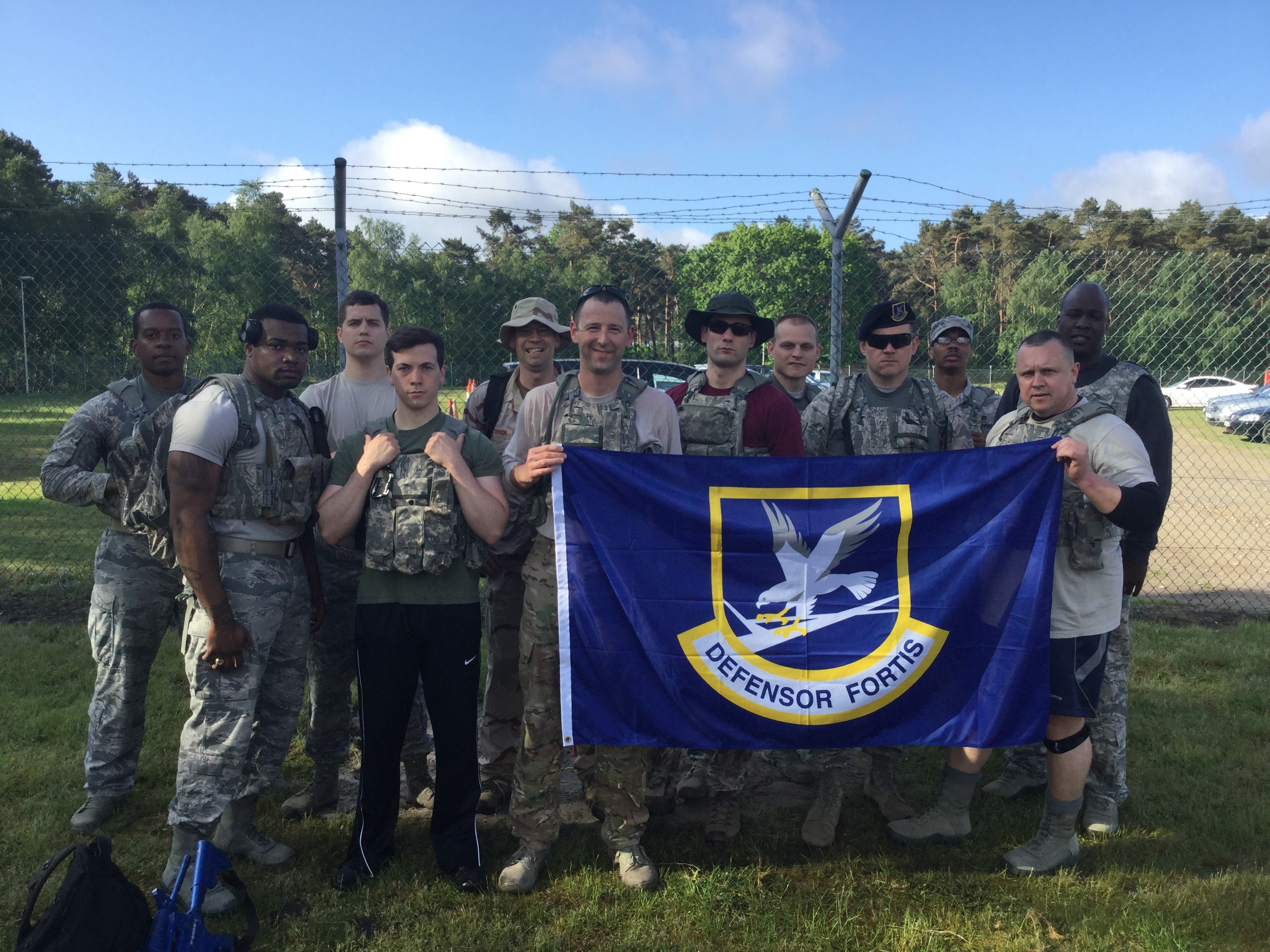
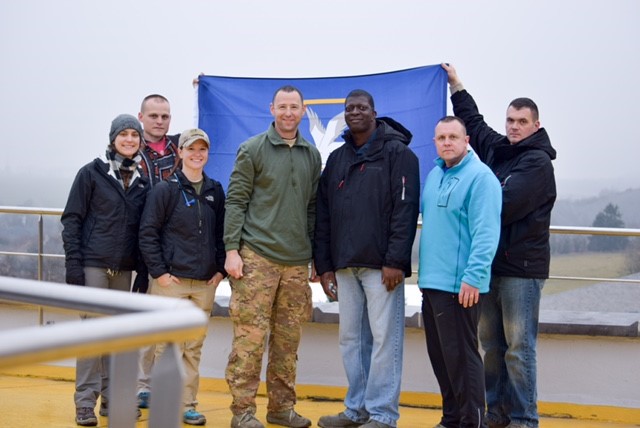
701 MUNSS/Custody Unit conducted a Police Week ruck march in 2016 and a reenlistment at the Bastogne War Memorial. The 701 MUNSS/Custody Forces was awarded the 2016 USAFE SF (GSU) Geographically Separated Unit of the Year award!
We love your AFSFA Security Forces Magazine over here. Keep it up!
PHILLIP B. FERRIS, Maj, USAF
Chief, Security Forces
701st Munitions Support Squadron
Kleine Brogel Air Base, Belgium
Well done Defenders ... keep up the good fight.
AFSFA
AFSFA Travis Bay Area Chapter 60SFS Monthly Defender Award
By Jim Downey, Travis Bay Area Chapter Chairman
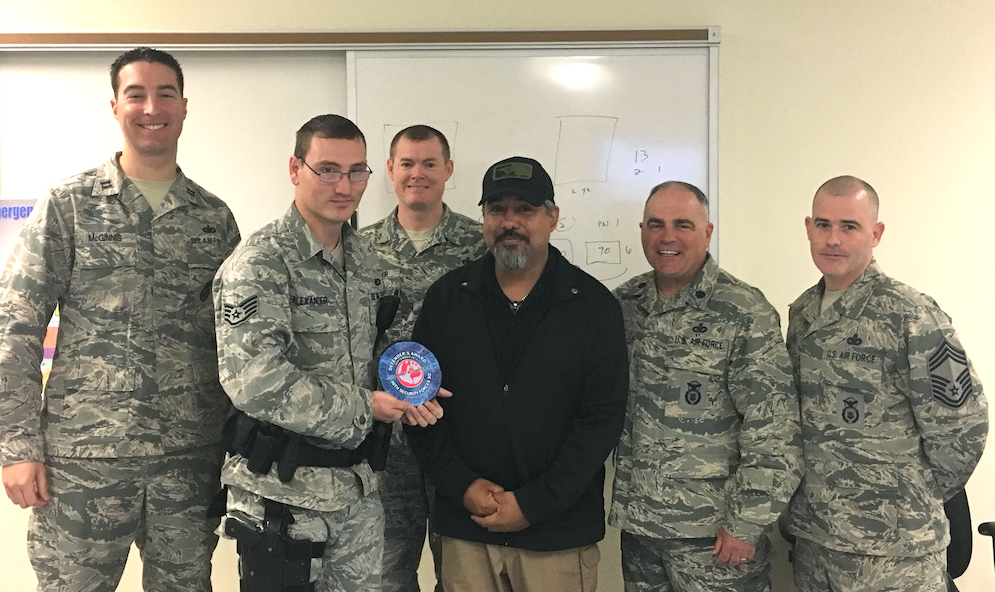
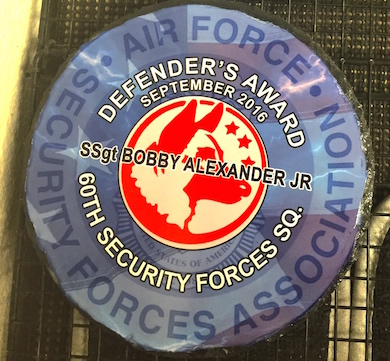
Photos from left to right: Capt Matthew McGinnis, SSgt Bobby Alexander, SMSgt Jeffrey Wheeler, Ron Armenta (TBAC), Lt Col Joseph Quinn (Commander) and CMSgt Joseph Ilsley; and Defender Award.
Travis Bay Area Chapter Sponsors Monthly Defender Award
60th Security Forces Squadron with the support AFSFA Travis Bay Area Chapter has begun presenting a monthly Defender Award. AFSFA-TBAC members agreed to fund the project and 60SFS leadership established the award criteria. The Award is open to both military and civilian members of 60SFS.
TBAC member Ron Armenta and Chapter 2nd Vice Chair owns TCGEP Designs. Ron worked with 60SFS on the design featuring the AFSFA logo as the background on a 7” round piece of slate with edges relieved. The award showcases a red sheepdog on white background in the center with the award winner’s name across the middle. The award is presented at Commanders Call and provided a tabletop holder for presentation.
The first Defender Award presentation was made to SSgt Bobby Alexander. While Defenders are presented awards, decorations and medals throughout their career, squadron awards are significant reminders of outstanding contributions and duty performance recognized by peers and leaders of their unit.
Award submission criteria for 60SFS Defender’s Award: 1) Action photo of Airman or Civilian at work along with their rank, name, unit, office symbol, and hometown. 2) a write-up of 3-6 lines (bullets) about why the Airman, NCO, or Civilian deserves recognition. 3) Accomplishments are to be work-related only, no off-duty volunteer activities. 4) Include numbers and data points that make the nominee stand out from his/her peers.
Nominations are submitted by a supervisor to the individuals Flight Chief or Section Chief, who then submits it to the First Sergeant. The First Sergeant collects all nominations for each month and distributes them to the Section Superintendents for scoring. The top score is the Defender of the Month.
Military Law Enforcement Personnel Can Now Carry Their Own Guns onto Offutt Air Force Base
By Steve Liewer, Omaha World-Herald staff writer,
Feb 6, 2017
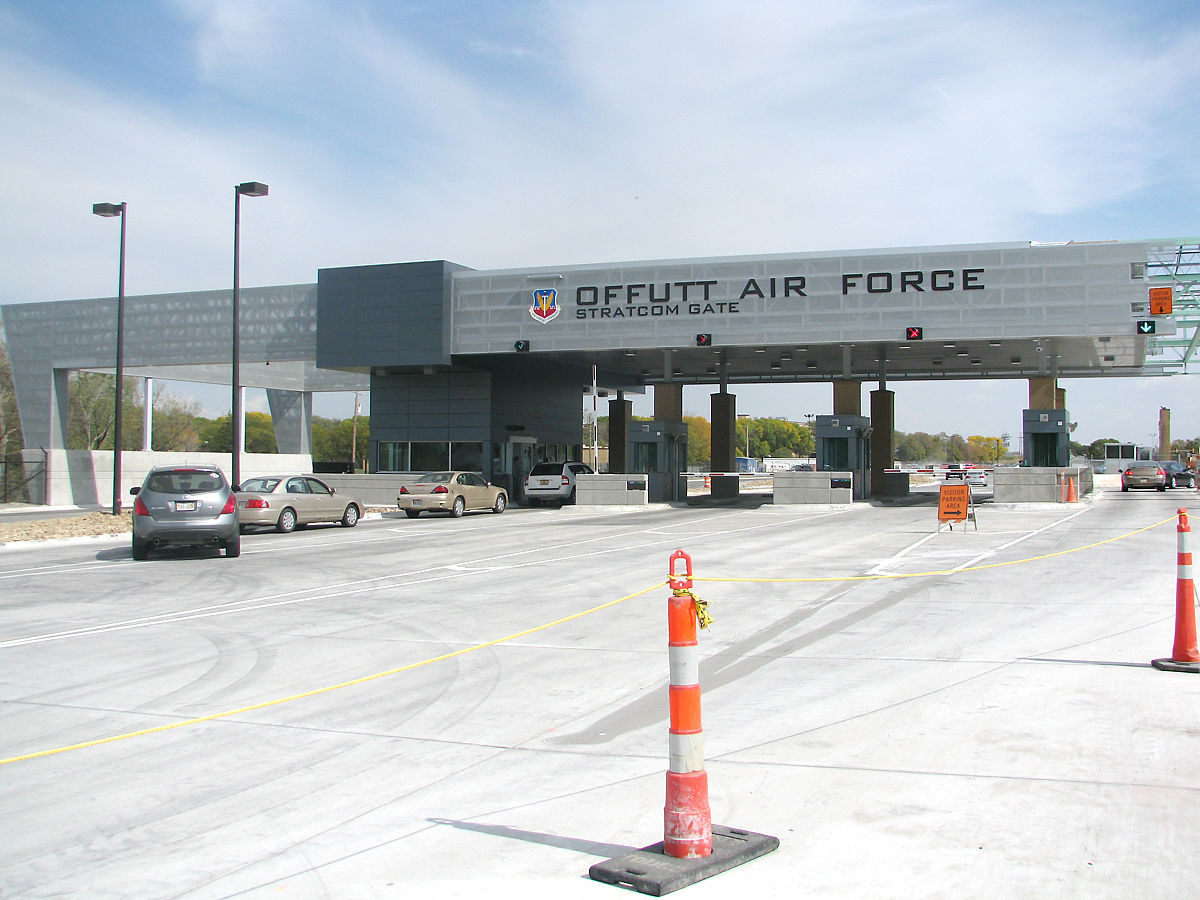
The Stratcom Gate at Offutt Air Force Base off Capehart Road in Bellevue.
Certain current and former military law enforcement personnel now may carry their personal firearms onto Offutt Air Force Base under a new 55th Wing policy.
The rule took effect Jan. 11 after nearly a year of planning and consideration and was not tied to any specific security threat against the base, said Lt. Col. Ian Dinesen, commander of the 55th Security Forces Squadron.
“We wanted to make sure it was very well-thought-out,” Dinesen said.
The new rules are allowed because of the 2014 expansion of a then-10-year-old federal law, the Law Enforcement Officers Safety Act, to allow military police with special permits to carry concealed weapons.
A post on Offutt’s Facebook page said the purpose was “to enhance existing force protection measures and potentially mitigate active-shooter or workplace violence events.”
In recent years, military posts have been the site of several mass shootings, including a 2009 terrorist attack by Nidal Hasan, an Army psychiatrist, at Fort Hood, Texas, that killed 13 soldiers and wounded more than 30; a spree at the Washington Navy Yard in 2013 in which a gunman killed 12 people and wounded four; and a second Fort Hood shooting in 2014 in which a distraught soldier killed three and wounded 16.
It may be counterintuitive to civilians, but military bases — including Offutt — have strict rules against carrying weapons. Only on-duty security officers may bring them on base. No one, not even someone with a concealed-carry permit, is allowed to bring personal weapons onto base, Dinesen said, except to carry them to and from an on-base residence, or to a firing range. In those cases, they must be carried unloaded, inside a locked case.
The federal law originally was passed in 2004, in the wake of the Sept. 11, 2001, terrorist attacks, to create a sort of auxiliary force of highly trained weapons specialists who could respond quickly in such emergencies, said James Baranowski, manager of external and international affairs for the National Rifle Association.
The law, widely known by the acronym LEOSA, allows qualifying law enforcement officers to carry permitted weapons across state and other jurisdictional lines.
It created a sort of back-door form of “reciprocity,” an NRA-backed concept that allows holders of concealed-carry permits in one state to legally carry their weapons in every state.
“It’s certainly helped a lot of law enforcement officers, especially in states that are more restrictive of civilian carriers,” Baranowski said.
But the law was poorly drafted, he said. Some language in the law appeared to exclude military security officers.
Congress amended the law in 2010 and again in 2014, the latter time specifically allowing military police and law enforcement officers to qualify to receive the special LEOSA identification cards.
Since then, the Army and Air Force have issued guidelines to allow their current and former security officers to qualify for the ID cards. The Navy, which also has administrative authority over the Marine Corps, has not.
Just over a year ago, the Air Force also gave base commanders authority to allow military LEOSA cardholders to carry their weapons onto bases. Baranowski said he thinks Offutt is among the first bases to do so.
The cards still aren’t easy to get. Only airmen or veterans with more than 10 years of experience as military security officers may qualify. They must go through stringent recertification training each year and pay a fee of up to several hundred dollars a year.
“You’re talking about people with quite a bit of service under their belt, even to be considered,” Dinesen said.
Cardholders also must secure their weapons and declare them at the gate before their vehicle is screened.
Even with the rules change, many major buildings and offices at Offutt will remain off-limits.
“I can’t carry it right now, sitting in my office as the squadron commander,” said Dinesen, who has one of the permits.
Nationwide, about 1,180 current and former Air Force security officers have qualified for LEOSA permits. Another 200 have applied and are waiting for certification.
Dinesen said about two dozen have filed permits with his security office.
“There’s really not a whole lot of people carrying,” Baranowski said.
Breaking the Stereotype: Tutus to Takedowns
by: Senior Airman Elizabeth Baker,
Stars & Stripes Japan, Yokota Air Base, published: February 04, 2017
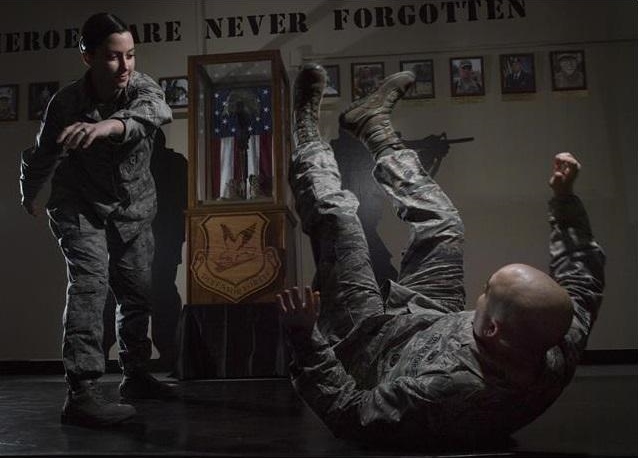
Staff Sgt. Kiirsten Gunterman, 374th Security Forces Squadron training instructor, performs a takedown on Senior Airman Ryan Vanicek, 374 SFS unit training manager at Yokota Air Base, Japan, Jan. 20, 2017. Gunterman spent 17 years practicing ballet before joining the Air Force. Her duties include instructing Combatives classes, where she teaches defenders to overcome larger, stronger oponents. (U.S. Air Force photo by Senior Airman Elizabeth Baker)
YOKOTA AIR BASE, Japan -- Air Force Security forces personnel exist to secure, defend and fight. Their responsibilities include protecting some of the world’s most potentially lethal weapons, securing air bases around the globe and handling combat arms. The kind of person who aspires to become an Air Force defender might be passionate about criminal justice, or attracted to danger or practice… ballet?
Standing a little over 5 feet, with the typical petite, slender and poised stature of a dancer, Staff Sgt. Kiirsten Gunterman,374th Security Forces Squadron training instructor, practiced ballet for 17 years before she joined the Air Force. With her passion for dance and her role as a defender, personnel like Gunterman demonstrate that in the Air Force there are always those who will break stereotypes. Whether male or female, ballerina or mechanic, drive and attitude are what make an Airman.
“People expected me to fail,” Gunterman said.
Before she joined, Gunterman visited recruiters from every branch. After watching an Air Force recruiting video about Security Forces, she decided the job was perfect and signed to be a cop.
“When I joined the military it surprised a lot of people,” Gunterman said as she looked toward the ceiling, reaching back to memories of her senior high school year in Chico, California. “I was the dancer, I did cheerleading and other things. People were saying ‘Does she know what she just signed up for?’ Now here I am, a military police officer.”
According to Gunterman, joining the military may have been a leap of faith but she embraced where it lead her.
“I definitely made the right decision joining the Air Force,” Gunterman said without hesitation. “Having my airmen is my favorite part. I didn’t think it would be but it’s really rewarding to see your airmen succeed. And to have them come up to you and say ‘Thank you for being the way you are,’ it hits you right in the heart.”
“Exuberance,” said Senior Airman Ryan Vanicek said with a smile when asked to describe her.
Vanicek, who is a 374 SFS unit scheduler, said he looks to Gunterman not only as his supervisor but as a role model. While firm, she does not come off as gruff in any way. Rather, Gunterman is endlessly enthusiastic.
“If I had to describe Staff Sgt. Kiirstyn Gunterman in a couple of words, another would be fierce,” Vanicek said lightheartedly but with conviction. “Her presence is strong. You always know when she is in a room.”
Gunterman says she loves her job. She spoke with energy about the study opportunities, the people she has met and the places she has been. Yet, in younger years, Gunterman never would have expected to end up where she is today.
“I had every intention of moving to the east coast and going to the college of my dreams and dancing with the New York Ballet Company,” Gunterman said. “That was gonna be my life.”
When Gunterman talks about dance and the dancers she admires, she becomes energized by thoughts of beauty and creativity.
“I think dance is really beautiful,” Gunterman said, her brown eyes turning to the side to follow her imagination. “When you see a dancer put their heart and soul into a piece, you can feel it. If someone loves what they’re doing and the story they’re telling, it becomes art that’s living, breathing and fluid. I think it’s one of the most beautiful art forms there is.”
Before graduating high school, Gunterman experienced events that changed the way she saw the world.
“When I was 16 my parents split up and my outlook on the world changed a little bit,” Gunterman said and paused briefly before continuing. “I made some changes but I love my life now.”
While hunting for a new direction, Gunterman turned to the Air Force: a branch she’d admired since she was young.
“I’d always thought of the Air Force as the best of the best,” Gunterman said. “They were the innovators, doing the big things in the world, and I wanted to do big things in the world. I said ‘I wanna go make change.’”
The young woman set out to become a defender, yet, the journey wasn’t easy from the start. Though years of dance had built her strength, Basic Military Training challenged her with 40 minute runs that required the kind of cardio stamina she simply didn’t have.
However, Gunterman pressed on, became an Airman, trained and learned. She pressed on through days where she began to doubt her decision.
“It was raining, 30 degrees, standing outside guarding a nuclear weapon and I was like ‘This sucks!’” Gunterman said, her eyes widening. “There were times in Colorado, in negative 17 degrees, standing at the gate and checking identification cards. You start to fantasize about what could have been.”
According to Gunterman, never was her self-drive more challenged than when she volunteered to become a Combatives instructor.
All SFS personnel have to stay current in techniques, largely based on jiu-jitsu ground fighting, which allow them to subdue an individual without taking or causing injuries. They practice these techniques in a class called Combatives.
“When I started learning to be an instructor, I didn’t think I could do it,” Gunterman said. “It whooped my butt. I’ve never been that sore in my entire life.”
Gunterman experienced mental and physical exhaustion in a class where she was the only female. Larger classmates continually defeated her and yet, by the end of the class, she learned to overcome them.
“Doing ballet taught me discipline,” Gunterman said. “They give you a task and you have to keep doing it and doing it to perfect it, no matter how much your feet bleed or your legs hurt. I knew people were relying on me to perfect that task because I needed to know it for a piece or a competition.”
Though Gunterman may have doubted herself at times and others may have seen her as an unlikely candidate for the military or SFS, none of that ever made this ballerina-cop quit.
“I’ve had people along the way tell me ‘You’re too girly’ or ‘This career field doesn’t seem too right for you,’ Gunterman said. “But I’ve made it my own experience. My outlook is, ‘you’re not getting out of life alive so you may as well have a good time with it. It sucks being in 17 degree weather but tomorrow I may not be. Or here I am checking IDs but if I wasn’t here these people couldn’t come on base and go to their homes.’”
Gunterman’s determination has made an impression on others too.
“She has never been one to be told something can't be done,” Vanicek said. “I have watched her many times find a way even if she had to make a way. On the other side of the coin, she is compassionate and cares for her subordinates, to include myself. She is empowering, I have grown more as an Airman during my time with her than probably any other time in my career.”
Perhaps it should have been apparent from the moment Gunterman decided to be a cop that she would become one and a good one. Being a ballerina didn’t mean she couldn’t handle SFS. In fact, it built her physical, mental and emotional discipline.
“I think that women get a bad rap sometimes,” Gunterman said. “I think we get underestimated a little in every branch.”
When Gunterman was asked what she would say to other young women who may be intimidated about joining the Air Force, she considered her response carefully.
“Sometimes you have to take a leap of faith,” Gunterman said. “People in the Air Force won’t let you fall flat on your face. Everyone wants you to succeed. This is a family. Why not to the next adventure? I started my life in Chico, California, and now I’m here. I can’t wait for the next adventure that comes.”
So far, Gunterman’s drive and her attitude have carried her to where she is today and made her what she is: a dancer and a hell of an Airman.
Page 40 of 51


